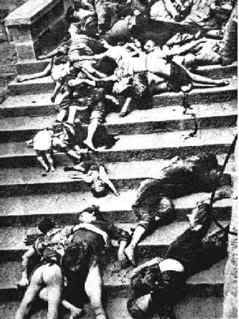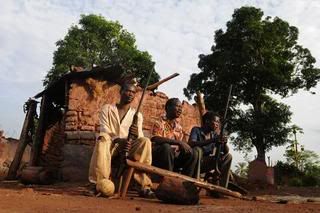Throughout history, the weapon of rape has played a role and often accompanied acts of war between different cultures and countries. With the goal being to humiliate and devastate communities, this weapon shows the supremacy and dominance of the conqueror via the sexual violation of women. Despite being horrifically gruesome and inhumane, it is a seemingly effective weapon due to the silence of the victims. In addition to the negative physical effects, after acts of rape, women often suffer from a loss of self-esteem and as a result, feel weak and dejected (RAINN). This state of depression, then, does nothing to prevent future attacks from occurring.
 Although this weapon has existed since biblical times, there are a few major events in the modern era that have embodied the destruction of rape. Shown to the world via photographs, the infamous Rape of Nanking in 1937 was one incident that displayed the magnitude of destruction that rape can have on a culture. During this particular massacre, an estimated 20-80,000 Chinese women were raped by invading Japanese solders, many of whom were physically beaten, sexually abused, and then slaughtered. (BBC News…The Rape of Nanking)
Although this weapon has existed since biblical times, there are a few major events in the modern era that have embodied the destruction of rape. Shown to the world via photographs, the infamous Rape of Nanking in 1937 was one incident that displayed the magnitude of destruction that rape can have on a culture. During this particular massacre, an estimated 20-80,000 Chinese women were raped by invading Japanese solders, many of whom were physically beaten, sexually abused, and then slaughtered. (BBC News…The Rape of Nanking)
 When one first looks at the photo, the girl immediately stands out, which plays an important role in the argument of the photo. One powerful element that contributes to this focal point is the way in which the image is framed and cropped. By isolating the general subjects of the photo: the receding room, the wall, and the girl, the number of elements available to the viewer is limited. Thus, via logos, the image is better able to “shap[e] someone else’s attention,” meaning the viewer’s (Compose, Design, Advocate, 285). In restricting the number of elements within the frame, the photo is able to direct the reader’s attention to specific aspects of the photo, which is where the visual hierarchy becomes important. Within this particular photo, the pinnacle of the hierarchy includes the girl, as she is the closest to the viewer. At this point, the viewer might briefly realize that she has a certain gesture to her, and could later return to examine this vector of attention in more depth.
When one first looks at the photo, the girl immediately stands out, which plays an important role in the argument of the photo. One powerful element that contributes to this focal point is the way in which the image is framed and cropped. By isolating the general subjects of the photo: the receding room, the wall, and the girl, the number of elements available to the viewer is limited. Thus, via logos, the image is better able to “shap[e] someone else’s attention,” meaning the viewer’s (Compose, Design, Advocate, 285). In restricting the number of elements within the frame, the photo is able to direct the reader’s attention to specific aspects of the photo, which is where the visual hierarchy becomes important. Within this particular photo, the pinnacle of the hierarchy includes the girl, as she is the closest to the viewer. At this point, the viewer might briefly realize that she has a certain gesture to her, and could later return to examine this vector of attention in more depth.
After looking at the girl, the alignment of these key elements proceeds to direct the eyes of the audience to the condition of the building, presumably her house. The particular elements that are examined include the wall located behind the girl, as well as the receding room engulfed in shadow. Since they are the only other general subjects in the picture besides the girl, their vertical alignment and overall positioning make them important elements, although not as significant as the woman. In addition, since they are lower in the hierarchy, they serve as merely a backdrop to explain why the girl is acting in the way that she is. In this manner, one might see the clear division between the end of the wall and the empty room as a narrative to the image. Assuming the girl has been raped, (implied by the title), she has come from the secluded room to try and move on with her life, though she cannot forget it completely under her own power. This appeal to pathos through logos depicts the situation in a negative manner, as pertaining to the condition of the house. It also forces the audience to further examine the focal point of the photo, which is the girl.
Besides the framing and alignment of the photo, the coloration is another key element that relates to the argument of the image. In looking at the photo, there are generally two categories of color that are used. The receding room, which comprises the left third of the frame, as well as the wall are both dark hues: black and brown. The girl, however, is wearing a white top and blue jeans, which are much brighter hues. This difference in coloration creates high contrast between the girl and her background, thus reinforcing the notion that she is at the peak of the hierarchy. Furthermore, these hues enforce the narrative of the photo, as the dark hues from the shadows of the room are logically associated with the negative experiences the girl has had (rape). She has come out of that room, or her past, however, to stand against the wall, only to have some of the shadow tag along with her. This narrative, supported by the alignment and coloration, also reinforces the girl as the primary element of the photo, and plants a seed in the viewer that the girl needs assistance to feel safe and hopeful.
As the image uses various appeals to logos to direct the attention of the audience toward the woman, she is presented as the primary vector of attention within the photo. Positioned as such, further examination of her gestures reveals that her left hand covers her face, and so again, using logic, the audience looks to her body position and body language to figure out what she is doing. Vectors of attention do not pertain solely to the logos of a picture, however. As stated in Compose, Design, Advocate on page 352, “Vectors of attention are thus about…emotional connections within the photograph as well as between the photograph and the audience.” In this manner, the gestures that are portrayed by the girl’s body language contribute vastly to the pathos of this photo. With her left hand covering her face, the girl is hiding from the lens of the camera. Looking at the picture, then, the audience is unable to establish eye contact with her, which distances them somewhat from her specific situation. As onlookers, the issue then becomes the reason that she has masked her face. Logically, this body language might have something to do with her emotional state. In Compose, Design, Advocate, the author mentions “obvious pathos.” He says, “When we see people in a photograph, we might identify with them: we understand the situation they are in through our own experiences” (274). Although it is unlikely that many members of the audience have first-hand experience with rape, it makes sense that feelings pertaining to shame, embarrassment, or emotional instability might provoke such a response. Furthermore, these feelings are generally associated with victims of rape (RAINN). Thus, as onlookers, the pathos produced in the audience is one of sympathy, as the girl should not have to live in such an environment. Especially from a Western standpoint, which emphasizes humanity for all, the audience would most likely feel as though something needs to be done to improve and prevent this inhumane situation from occurring.
 Through the use of isolation framing and contrasting coloration to highlight the woman as a vector of attention, the photo Tales of Rape in DR Congo supports the argument through pathos and logos that assistance and support is needed in this region. With the history of rape as seen through incidences such as the Rape of Nanking, as well as the current published photos and articles of the Congo, this image provokes a feeling of sympathy as pertaining to its audience. Looking at this situation from a Western perspective, however, this issue goes beyond this feeling of sympathy. What can be done to assist these victims of rape? Surely such mutiny of communities is inhumane and intolerable, but how is one to put an end to the situation? Although the problem lies with the armed forces in the region, in some cases it is against the same national army that is supposed to be protecting Congo citizens from the harm of neighboring countries. Perhaps the photo not only gives us insight into such a problem, but to the solution as well. The women of the area must not be afraid to unite and show their true faces.
Through the use of isolation framing and contrasting coloration to highlight the woman as a vector of attention, the photo Tales of Rape in DR Congo supports the argument through pathos and logos that assistance and support is needed in this region. With the history of rape as seen through incidences such as the Rape of Nanking, as well as the current published photos and articles of the Congo, this image provokes a feeling of sympathy as pertaining to its audience. Looking at this situation from a Western perspective, however, this issue goes beyond this feeling of sympathy. What can be done to assist these victims of rape? Surely such mutiny of communities is inhumane and intolerable, but how is one to put an end to the situation? Although the problem lies with the armed forces in the region, in some cases it is against the same national army that is supposed to be protecting Congo citizens from the harm of neighboring countries. Perhaps the photo not only gives us insight into such a problem, but to the solution as well. The women of the area must not be afraid to unite and show their true faces.
"BBC News, World, Scarred by history: The Rape of Nanking." BBC NEWS News Front Page. 13 Dec. 1997. Web. 01 Mar. 2010.
"BBC NEWS: Photo journal: Tales of rape in DR Congo." BBC NEWS, News Front Page. 2007. 17 Feb. 2010
"CIA - The World Factbook -- Congo, Democratic Republic of the." Welcome to the CIA Web Site Central Intelligence Agency. 15 Jan. 2010. 18 Feb. 2010
"Effects of Sexual Assault RAINN Rape, Abuse and Incest National Network." RAINN; Rape, Abuse and Incest National Network. 31 Feb. 2010. Web. 04 Mar. 2010.
 When one first looks at the photo, the girl immediately stands out, which plays an important role in the argument of the photo.
When one first looks at the photo, the girl immediately stands out, which plays an important role in the argument of the photo.